Filed Under #qualitative_modelling
Mar 1, 2025
 This blog post summarises one of the results I obtained from some work I did back in 2015 with Eve McDonald-Madden at the University of Queensland. She didn’t end up using it for anything, but perhaps someone else might find it useful. Modellers using the Qualitative Modelling approach often model a species eradication as a press-perturbation. This is obviously wrong, but it’s convenient and has a certain intuitive appeal, and it’s not known how often it gives answers that are wrong enough to matter. In this blog post, I provide a fast method to predict the effects of an eradication...
This blog post summarises one of the results I obtained from some work I did back in 2015 with Eve McDonald-Madden at the University of Queensland. She didn’t end up using it for anything, but perhaps someone else might find it useful. Modellers using the Qualitative Modelling approach often model a species eradication as a press-perturbation. This is obviously wrong, but it’s convenient and has a certain intuitive appeal, and it’s not known how often it gives answers that are wrong enough to matter. In this blog post, I provide a fast method to predict the effects of an eradication...
Predicting the effects of species eradication from the community matrix alone
 This blog post summarises one of the results I obtained from some work I did back in 2015 with Eve McDonald-Madden at the University of Queensland. She didn’t end up using it for anything, but perhaps someone else might find it useful. Modellers using the Qualitative Modelling approach often model a species eradication as a press-perturbation. This is obviously wrong, but it’s convenient and has a certain intuitive appeal, and it’s not known how often it gives answers that are wrong enough to matter. In this blog post, I provide a fast method to predict the effects of an eradication...
This blog post summarises one of the results I obtained from some work I did back in 2015 with Eve McDonald-Madden at the University of Queensland. She didn’t end up using it for anything, but perhaps someone else might find it useful. Modellers using the Qualitative Modelling approach often model a species eradication as a press-perturbation. This is obviously wrong, but it’s convenient and has a certain intuitive appeal, and it’s not known how often it gives answers that are wrong enough to matter. In this blog post, I provide a fast method to predict the effects of an eradication...
Jun 10, 2020
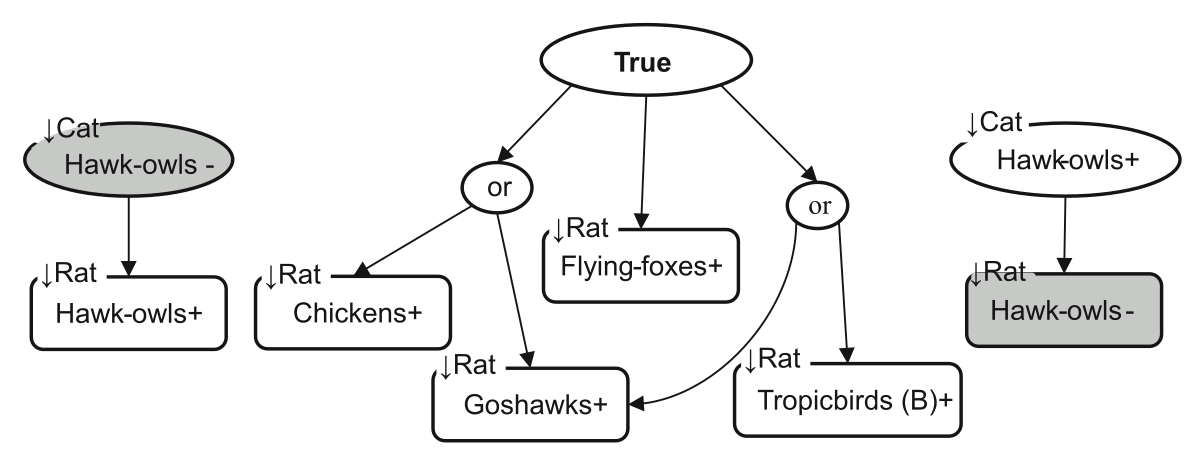 Conservation managers often want us to predict how species will respond to different management options when we don’t have enough data to parameterise a dynamical model. Previously, we found that a popular Qualitative Modelling technique involving probabilistic analysis has philosophical problems and produces contradictory results. We proposed a new method, based on Boolean analysis, that remedied these problems (Kristensen et al. 2019 Meth Ecol Evol). However, it was still an open question how the Boolean approach would perform in a real-world application. Yi Han’s new paper in Ecological Modelling is the first time the Boolean approach has been applied to...
Conservation managers often want us to predict how species will respond to different management options when we don’t have enough data to parameterise a dynamical model. Previously, we found that a popular Qualitative Modelling technique involving probabilistic analysis has philosophical problems and produces contradictory results. We proposed a new method, based on Boolean analysis, that remedied these problems (Kristensen et al. 2019 Meth Ecol Evol). However, it was still an open question how the Boolean approach would perform in a real-world application. Yi Han’s new paper in Ecological Modelling is the first time the Boolean approach has been applied to...
Boolean qualitative modelling on Christmas Island
 Conservation managers often want us to predict how species will respond to different management options when we don’t have enough data to parameterise a dynamical model. Previously, we found that a popular Qualitative Modelling technique involving probabilistic analysis has philosophical problems and produces contradictory results. We proposed a new method, based on Boolean analysis, that remedied these problems (Kristensen et al. 2019 Meth Ecol Evol). However, it was still an open question how the Boolean approach would perform in a real-world application. Yi Han’s new paper in Ecological Modelling is the first time the Boolean approach has been applied to...
Conservation managers often want us to predict how species will respond to different management options when we don’t have enough data to parameterise a dynamical model. Previously, we found that a popular Qualitative Modelling technique involving probabilistic analysis has philosophical problems and produces contradictory results. We proposed a new method, based on Boolean analysis, that remedied these problems (Kristensen et al. 2019 Meth Ecol Evol). However, it was still an open question how the Boolean approach would perform in a real-world application. Yi Han’s new paper in Ecological Modelling is the first time the Boolean approach has been applied to...
Jul 25, 2019
Typo in qualitative modelling paper
There is a typo in our recent paper to MEE, Dealing with high uncertainty in qualitative network models using Boolean analysis. Example 2 of Box 1 should read “y = water/wine” not “y = wine/water”. Many thanks to Anubhav Gupta at University of Zurich for emailing us to let us know.Apr 11, 2019
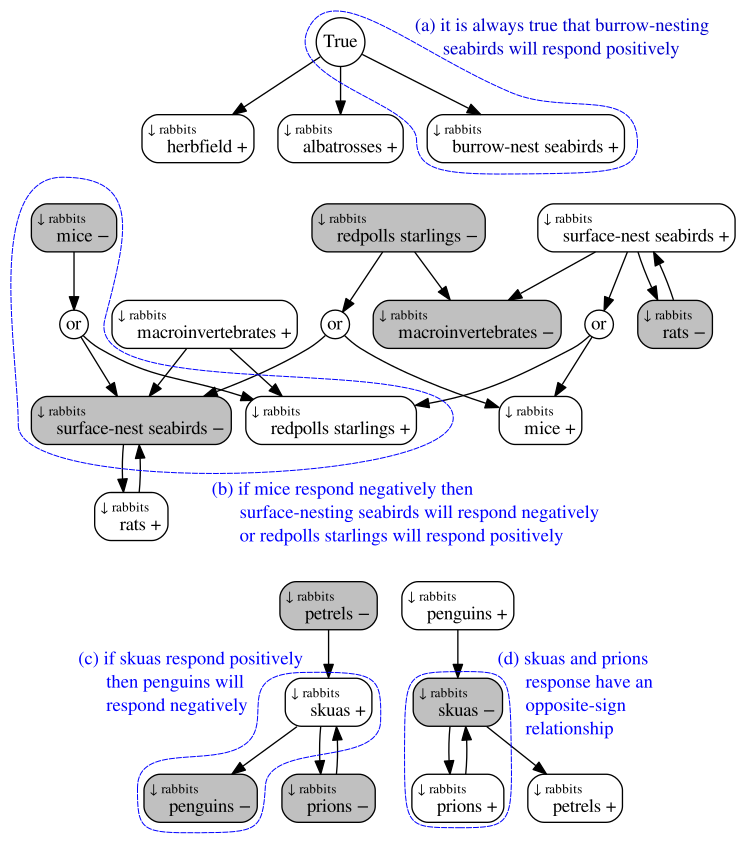 In a new paper in Methods in Ecology and Evolution (draft with supplementary here), we tackled an important question for ecological modellers: how do we predict an ecosystem’s behaviour when the data needed to parameterise a model are lacking? This problem is particularly important when our models are needed for conservation decision-making. For example, managers may be considering different pest-control programmes, which have the potential to lead to negative outcomes for native species, and predictions of these outcomes are needed for sound decisions to be made. These outcomes can in principle be predicted using dynamical models, however experts rarely have...
In a new paper in Methods in Ecology and Evolution (draft with supplementary here), we tackled an important question for ecological modellers: how do we predict an ecosystem’s behaviour when the data needed to parameterise a model are lacking? This problem is particularly important when our models are needed for conservation decision-making. For example, managers may be considering different pest-control programmes, which have the potential to lead to negative outcomes for native species, and predictions of these outcomes are needed for sound decisions to be made. These outcomes can in principle be predicted using dynamical models, however experts rarely have...
Boolean approach to qualitative network modelling
 In a new paper in Methods in Ecology and Evolution (draft with supplementary here), we tackled an important question for ecological modellers: how do we predict an ecosystem’s behaviour when the data needed to parameterise a model are lacking? This problem is particularly important when our models are needed for conservation decision-making. For example, managers may be considering different pest-control programmes, which have the potential to lead to negative outcomes for native species, and predictions of these outcomes are needed for sound decisions to be made. These outcomes can in principle be predicted using dynamical models, however experts rarely have...
In a new paper in Methods in Ecology and Evolution (draft with supplementary here), we tackled an important question for ecological modellers: how do we predict an ecosystem’s behaviour when the data needed to parameterise a model are lacking? This problem is particularly important when our models are needed for conservation decision-making. For example, managers may be considering different pest-control programmes, which have the potential to lead to negative outcomes for native species, and predictions of these outcomes are needed for sound decisions to be made. These outcomes can in principle be predicted using dynamical models, however experts rarely have...
Feb 26, 2019
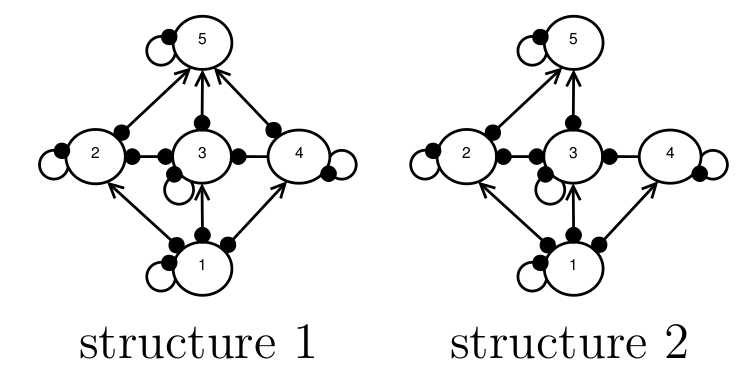 When conservation decision-makers attempt to predict the outcomes of management interventions, they frequently encounter uncertainty about the underlying ecosystem structure. Consider the example in Fig. 1, where experts are unsure whether species 4 and 5 interact. This uncertainty produces two possible structural configurations that could serve as model inputs. How might we determine which structure more accurately reflects reality? Melbourne-Thomas et al. (2012) proposed a Bayesian method to address this type of structural uncertainty. However, as I will discuss in this blog post, their approach favours simpler structures over more complex ones. Simpler structures predict fewer possible species-response outcomes. Therefore,...
When conservation decision-makers attempt to predict the outcomes of management interventions, they frequently encounter uncertainty about the underlying ecosystem structure. Consider the example in Fig. 1, where experts are unsure whether species 4 and 5 interact. This uncertainty produces two possible structural configurations that could serve as model inputs. How might we determine which structure more accurately reflects reality? Melbourne-Thomas et al. (2012) proposed a Bayesian method to address this type of structural uncertainty. However, as I will discuss in this blog post, their approach favours simpler structures over more complex ones. Simpler structures predict fewer possible species-response outcomes. Therefore,...
A Boolean approach to ecosystem structural uncertainty
 When conservation decision-makers attempt to predict the outcomes of management interventions, they frequently encounter uncertainty about the underlying ecosystem structure. Consider the example in Fig. 1, where experts are unsure whether species 4 and 5 interact. This uncertainty produces two possible structural configurations that could serve as model inputs. How might we determine which structure more accurately reflects reality? Melbourne-Thomas et al. (2012) proposed a Bayesian method to address this type of structural uncertainty. However, as I will discuss in this blog post, their approach favours simpler structures over more complex ones. Simpler structures predict fewer possible species-response outcomes. Therefore,...
When conservation decision-makers attempt to predict the outcomes of management interventions, they frequently encounter uncertainty about the underlying ecosystem structure. Consider the example in Fig. 1, where experts are unsure whether species 4 and 5 interact. This uncertainty produces two possible structural configurations that could serve as model inputs. How might we determine which structure more accurately reflects reality? Melbourne-Thomas et al. (2012) proposed a Bayesian method to address this type of structural uncertainty. However, as I will discuss in this blog post, their approach favours simpler structures over more complex ones. Simpler structures predict fewer possible species-response outcomes. Therefore,...
Feb 2, 2019
Why does it matter to conservation decision-making if alternative Qualitative Modelling methods produce contradictory predictions?
Previously, I have written about how the probabilistic approach to Qualitative Modelling (QM) (e.g. Raymond et al. 2011) can lead to contradictory predictions of species response to a management intervention, and how this is similar to the paradoxes of the Principle of Indifference that we find in the philosophy literature. A reviewer of our new manuscript (Kristensen et al. 2019) asked us an interesting and thought-provoking question: why is it that we think these contradictions matter? They did not find the contradictory predictions of the probabilistic QM methods to be a problem because it is interesting to learn how different...Feb 18, 2016
 Background Imagine a situation in which we want to model the behaviour of a food web, but we don’t know what the species interaction strengths are, and we’re not 100 percent sure what the structure of the food web is, either. For example, in the figure below, experts are are uncertain about whether or not there is a direct interaction between species 4 and 5, and so both structures 1 and 2 are possibilities. We want to know, which of these candidate structures is more likely to represent the true network structure? An example of network structural uncertainty. Experts are...
Background Imagine a situation in which we want to model the behaviour of a food web, but we don’t know what the species interaction strengths are, and we’re not 100 percent sure what the structure of the food web is, either. For example, in the figure below, experts are are uncertain about whether or not there is a direct interaction between species 4 and 5, and so both structures 1 and 2 are possibilities. We want to know, which of these candidate structures is more likely to represent the true network structure? An example of network structural uncertainty. Experts are...
Network structural uncertainty in Qualitative Modelling
 Background Imagine a situation in which we want to model the behaviour of a food web, but we don’t know what the species interaction strengths are, and we’re not 100 percent sure what the structure of the food web is, either. For example, in the figure below, experts are are uncertain about whether or not there is a direct interaction between species 4 and 5, and so both structures 1 and 2 are possibilities. We want to know, which of these candidate structures is more likely to represent the true network structure? An example of network structural uncertainty. Experts are...
Background Imagine a situation in which we want to model the behaviour of a food web, but we don’t know what the species interaction strengths are, and we’re not 100 percent sure what the structure of the food web is, either. For example, in the figure below, experts are are uncertain about whether or not there is a direct interaction between species 4 and 5, and so both structures 1 and 2 are possibilities. We want to know, which of these candidate structures is more likely to represent the true network structure? An example of network structural uncertainty. Experts are...
Jan 19, 2016
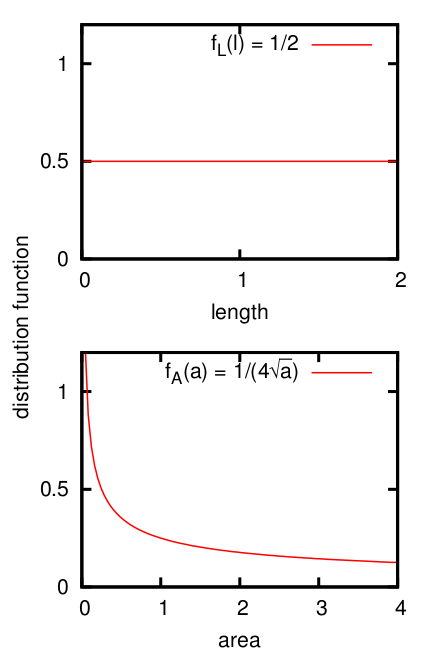 A classical statement of the Principle of Indifference (PI) is as follows (p. 45 Keynes, 1921): if there is no known reason for predicating of our subject one rather than another of several alternatives, then relatively to such knowledge the assertions of each of these alternatives have an equal probability. Thus equal probabilities must be assigned to each of several arguments, if there is an absence of positive ground for assigning unequal ones. The various forms of PI encompass two ideas (Norton, 2008). First is a truism of evidence: if we have no grounds for distinguishing outcomes, then we should...
A classical statement of the Principle of Indifference (PI) is as follows (p. 45 Keynes, 1921): if there is no known reason for predicating of our subject one rather than another of several alternatives, then relatively to such knowledge the assertions of each of these alternatives have an equal probability. Thus equal probabilities must be assigned to each of several arguments, if there is an absence of positive ground for assigning unequal ones. The various forms of PI encompass two ideas (Norton, 2008). First is a truism of evidence: if we have no grounds for distinguishing outcomes, then we should...
Some notes on the Principle of Indifference
 A classical statement of the Principle of Indifference (PI) is as follows (p. 45 Keynes, 1921): if there is no known reason for predicating of our subject one rather than another of several alternatives, then relatively to such knowledge the assertions of each of these alternatives have an equal probability. Thus equal probabilities must be assigned to each of several arguments, if there is an absence of positive ground for assigning unequal ones. The various forms of PI encompass two ideas (Norton, 2008). First is a truism of evidence: if we have no grounds for distinguishing outcomes, then we should...
A classical statement of the Principle of Indifference (PI) is as follows (p. 45 Keynes, 1921): if there is no known reason for predicating of our subject one rather than another of several alternatives, then relatively to such knowledge the assertions of each of these alternatives have an equal probability. Thus equal probabilities must be assigned to each of several arguments, if there is an absence of positive ground for assigning unequal ones. The various forms of PI encompass two ideas (Norton, 2008). First is a truism of evidence: if we have no grounds for distinguishing outcomes, then we should...
Dec 15, 2015
Fibonacci numbers and alternating signs in species responses to press perturbation in a food chain
In a paper from 2001, Dambacher and Rossignol made a curious observation: Fibonacci numbers appear in the adjoint and absolute feedback matrices that result from a weighted-predictions matrix type analysis (Dambacher et al. 2003) on food chains. The weighted-predictions matrix analysis is a way of predicting how species in a food web will respond to a the press perturbation of one of the species, so that implies that the pattern of species response to certain kinds of disturbance follows a neat mathematical pattern. To understand where these Fibonacci numbers come from, a paper by Usmani (1994) is useful. First some...Nov 20, 2015
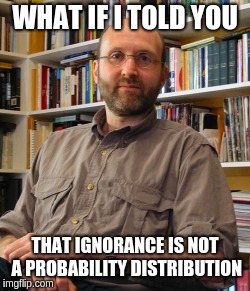 In a previous post, I wrote about the philosophical problems caused by the Principle of Indifference. The problems are illustrated with a variety of thought-experiments that create paradoxes, such as Bertrand’s paradox. I also discussed how a problem in ecological modelling for conservation decision-making seems closely related to this philosophical problem. When I realised this connection, it seemed to me that, in order to solve the ecological problem, I would need to solve the philosophical problem first. Reading the philosophy literature, however, I realised that solving the philosophical problem would not be so simple. As Shackel (2007) sums it up,...
In a previous post, I wrote about the philosophical problems caused by the Principle of Indifference. The problems are illustrated with a variety of thought-experiments that create paradoxes, such as Bertrand’s paradox. I also discussed how a problem in ecological modelling for conservation decision-making seems closely related to this philosophical problem. When I realised this connection, it seemed to me that, in order to solve the ecological problem, I would need to solve the philosophical problem first. Reading the philosophy literature, however, I realised that solving the philosophical problem would not be so simple. As Shackel (2007) sums it up,...
The Principle of Indifference is actually two principles in one
 In a previous post, I wrote about the philosophical problems caused by the Principle of Indifference. The problems are illustrated with a variety of thought-experiments that create paradoxes, such as Bertrand’s paradox. I also discussed how a problem in ecological modelling for conservation decision-making seems closely related to this philosophical problem. When I realised this connection, it seemed to me that, in order to solve the ecological problem, I would need to solve the philosophical problem first. Reading the philosophy literature, however, I realised that solving the philosophical problem would not be so simple. As Shackel (2007) sums it up,...
In a previous post, I wrote about the philosophical problems caused by the Principle of Indifference. The problems are illustrated with a variety of thought-experiments that create paradoxes, such as Bertrand’s paradox. I also discussed how a problem in ecological modelling for conservation decision-making seems closely related to this philosophical problem. When I realised this connection, it seemed to me that, in order to solve the ecological problem, I would need to solve the philosophical problem first. Reading the philosophy literature, however, I realised that solving the philosophical problem would not be so simple. As Shackel (2007) sums it up,...
Jun 17, 2015
"ValueError: expected a DNF expression" when trying espresso_exprs example from pyeda docs
I’ve recently been working on a qualitative modelling project where I am trying to uncover “truths” about the response of species in an ecosystem to control of invasive species. Long story short, I’ve been looking into various boolean minimisation techniques. I’ve been playing with Python EDA, a Python library that I think provides a front-end to the Robert Brayton and Richard Rudell espresso heuristic logic minimiser, developed at University of California, Berkeley. I was trying out the examples on the Two-level Logic Minimisation docs page, and I had no issues with the second ‘Minimise truth tables’ example. However for the...May 20, 2015
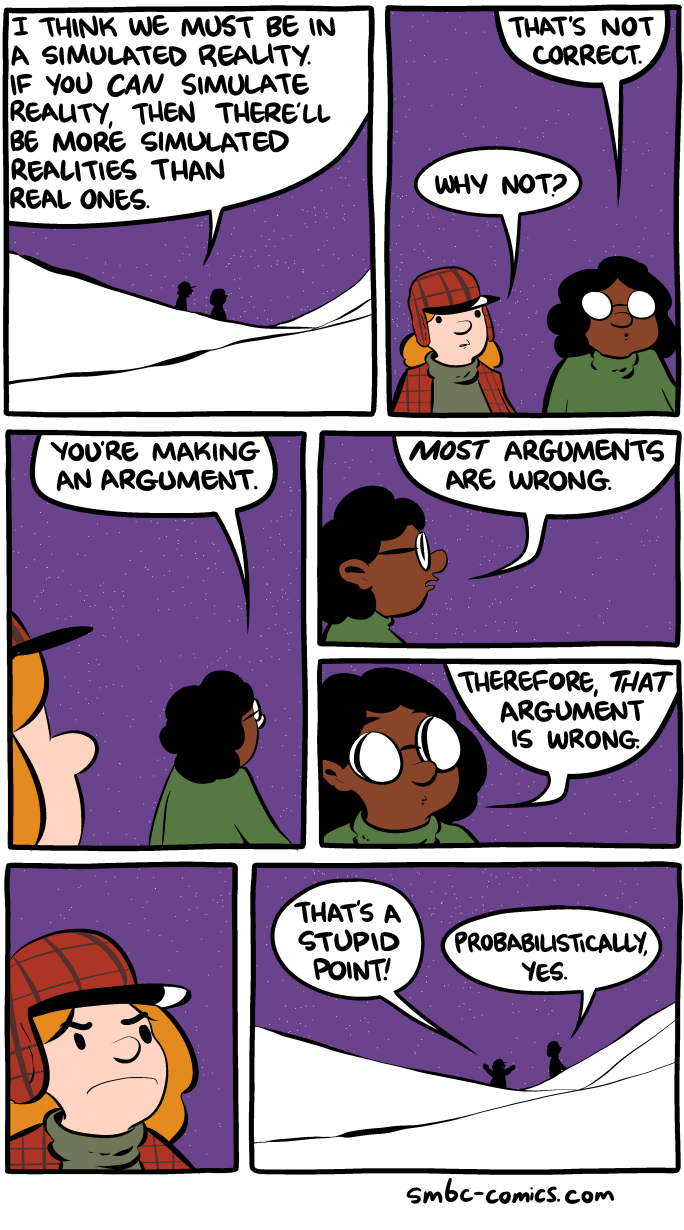 SMBC has a funny comic that’s also about the Principle of Indifference.
SMBC has a funny comic that’s also about the Principle of Indifference.